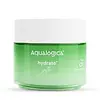What's inside
What's inside
 Key Ingredients
Key Ingredients

 Benefits
Benefits

 Concerns
Concerns

 Ingredients Side-by-side
Ingredients Side-by-side

Water
Skin ConditioningParaffinum Liquidum
EmollientGlycerin
HumectantBrassica Campestris Seed Oil
Skin ConditioningSodium Polyacrylate
AbsorbentPentylene Glycol
Skin ConditioningCetearyl Alcohol
Emollient1,2-Hexanediol
Skin ConditioningCaprylyl Glycol
EmollientAcrylates/C10-30 Alkyl Acrylate Crosspolymer
Emulsion StabilisingSodium Citrate
BufferingXylitol
HumectantCetearyl Glucoside
EmulsifyingMannitol
HumectantTocopherol
AntioxidantRhamnose
HumectantXylitylglucoside
HumectantHelianthus Annuus Seed Oil
EmollientAnhydroxylitol
HumectantNiacinamide
SmoothingGlucose
HumectantFructooligosaccharides
HumectantCaprylic/Capric Triglyceride
MaskingLaminaria Ochroleuca Extract
Skin ConditioningWater, Paraffinum Liquidum, Glycerin, Brassica Campestris Seed Oil, Sodium Polyacrylate, Pentylene Glycol, Cetearyl Alcohol, 1,2-Hexanediol, Caprylyl Glycol, Acrylates/C10-30 Alkyl Acrylate Crosspolymer, Sodium Citrate, Xylitol, Cetearyl Glucoside, Mannitol, Tocopherol, Rhamnose, Xylitylglucoside, Helianthus Annuus Seed Oil, Anhydroxylitol, Niacinamide, Glucose, Fructooligosaccharides, Caprylic/Capric Triglyceride, Laminaria Ochroleuca Extract
Water
Skin ConditioningButylene Glycol
HumectantHydroxyethyl Urea
HumectantHydrogenated Polyisobutene
EmollientSilica
AbrasiveAmmonium Polyacryloyldimethyl Taurate
Emulsion StabilisingN-Vinyl Pyrrolidone
Glycerin
HumectantSaccharide Isomerate
HumectantCitric Acid
BufferingSodium Citrate
BufferingCocos Nucifera Water
MaskingCetearyl Olivate
Sorbitan Olivate
EmulsifyingGlyceryl Glucoside
HumectantAloe Barbadensis Leaf Juice
Skin ConditioningPhenoxyethanol
PreservativeAvena Strigosa Seed Extract
Skin ConditioningLecithin
EmollientPotassium Sorbate
PreservativeAphanothece Sacrum Polysaccharide
AbsorbentSodium Hyaluronate
HumectantDisodium EDTA
Sodium Acrylates Copolymer
Parfum
MaskingCI 42053
Cosmetic ColorantCI 19140
Cosmetic ColorantCI 42090
Cosmetic ColorantWater, Butylene Glycol, Hydroxyethyl Urea, Hydrogenated Polyisobutene, Silica, Ammonium Polyacryloyldimethyl Taurate, N-Vinyl Pyrrolidone, Glycerin, Saccharide Isomerate, Citric Acid, Sodium Citrate, Cocos Nucifera Water, Cetearyl Olivate, Sorbitan Olivate, Glyceryl Glucoside, Aloe Barbadensis Leaf Juice, Phenoxyethanol, Avena Strigosa Seed Extract, Lecithin, Potassium Sorbate, Aphanothece Sacrum Polysaccharide, Sodium Hyaluronate, Disodium EDTA, Sodium Acrylates Copolymer, Parfum, CI 42053, CI 19140, CI 42090
 Reviews
Reviews

Ingredients Explained
These ingredients are found in both products.
Ingredients higher up in an ingredient list are typically present in a larger amount.
Glycerin is already naturally found in your skin. It helps moisturize and protect your skin.
A study from 2016 found glycerin to be more effective as a humectant than AHAs and hyaluronic acid.
As a humectant, it helps the skin stay hydrated by pulling moisture to your skin. The low molecular weight of glycerin allows it to pull moisture into the deeper layers of your skin.
Hydrated skin improves your skin barrier; Your skin barrier helps protect against irritants and bacteria.
Glycerin has also been found to have antimicrobial and antiviral properties. Due to these properties, glycerin is often used in wound and burn treatments.
In cosmetics, glycerin is usually derived from plants such as soybean or palm. However, it can also be sourced from animals, such as tallow or animal fat.
This ingredient is organic, colorless, odorless, and non-toxic.
Glycerin is the name for this ingredient in American English. British English uses Glycerol/Glycerine.
Learn more about GlycerinSodium Citrate is the sodium salts of citric acid. In skincare, it is used to alter pH levels and acts as a preservative.
Its main functions are to maintain the pH of a product and neutralize metal ions.
The acidity of our skin is maintained by our glands and skin biome; normal pH level of skin is slightly acidic (~4.75-5.5).
Being slightly acidic allows our skin to create an "acid mantle". This acid mantle is a thin barrier that protects our skin from bacteria and contaminants.
Learn more about Sodium CitrateWater. It's the most common cosmetic ingredient of all. You'll usually see it at the top of ingredient lists, meaning that it makes up the largest part of the product.
So why is it so popular? Water most often acts as a solvent - this means that it helps dissolve other ingredients into the formulation.
You'll also recognize water as that liquid we all need to stay alive. If you see this, drink a glass of water. Stay hydrated!
Learn more about Water